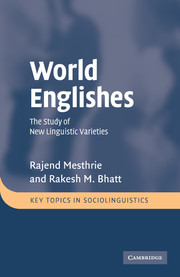Book contents
- Frontmatter
- Contents
- List of figures
- List of tables
- Preface
- Acknowledgements
- List of abbreviations
- 1 History: the spread of English
- 2 Structural features of New Englishes I: morphology and phrasal syntax
- 3 Structural features of New Englishes II: cross-clausal syntax and syntactic theory
- 4 More on structure: lexis and phonology
- 5 Pragmatics and discourse
- 6 Language contact and language acquisition issues in New English research
- 7 Conclusion: current trends in the spread of English
- Glossary
- Bibliography
- Author index
- Subject index
Preface
Published online by Cambridge University Press: 05 September 2012
- Frontmatter
- Contents
- List of figures
- List of tables
- Preface
- Acknowledgements
- List of abbreviations
- 1 History: the spread of English
- 2 Structural features of New Englishes I: morphology and phrasal syntax
- 3 Structural features of New Englishes II: cross-clausal syntax and syntactic theory
- 4 More on structure: lexis and phonology
- 5 Pragmatics and discourse
- 6 Language contact and language acquisition issues in New English research
- 7 Conclusion: current trends in the spread of English
- Glossary
- Bibliography
- Author index
- Subject index
Summary
The study of varieties of English that began as second languages under the experience of British colonialism is not new, going back to the nineteenth century. As in all matters pertaining to language contact the name Hugo Schuchardt comes to mind, with his 1891 study Das Indo-Englische, which examines the properties of varieties of English in India, in the light of the author's interest in Creole and other contact languages. Within the colonies, some scholars had also tried to inculcate the serious study of the local varieties of English, as opposed to satirical works or grammars, promising to weed out the unconventional in these varieties. The influence of Firoz Dustoor in the middle of the twentieth century at Allahabad and later Delhi is cited by Braj Kachru. It is safe to say that until the 1980s most work tended to discuss individual varieties of colonial English in isolation. The comparative study of what has more or less come to be called ‘World Englishes’ is due to the pioneering efforts of many scholars. (‘New Englishes’ is a near-synonym, which we occasionally employ.) Of these scholars Braj Kachru, once of Kashmir, then Edinburgh and finally Urbana-Champaign, probably deserves the most credit for establishing this subfield. It is due to his enthusiasm, vigorous insights and charisma that the area of study entered the mainstream of Sociolinguistics. Other scholars have played important pioneering roles.
- Type
- Chapter
- Information
- World EnglishesThe Study of New Linguistic Varieties, pp. xi - xiiiPublisher: Cambridge University PressPrint publication year: 2008

